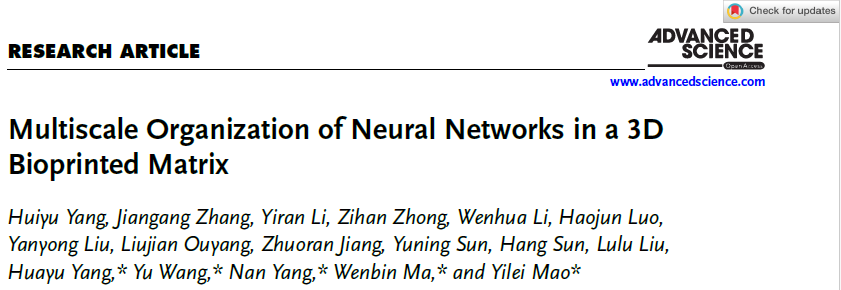In the field of neuroscience research, constructing in vitro models that accurately mimic brain structure and function has been an enduring challenge for scientists. Recently, a team led by Prof. Mao Yilei from the Department of Liver Surgery and Prof. Ma Wenbin from the Department of Neurosurgery at PUMCH, in collaboration with Associate Professor Yang Nan's team from the Institute of Basic Medical Sciences at the Chinese Academy of Medical Sciences, published breakthrough findings in Advanced Science. The team utilized 3D bioprinting technology to construct a "mini-brain" called 3D neuMatrix, providing a high-fidelity "testing ground" for research in neurodevelopment, disease modeling, drug screening, and other related fields. This research was supported by the National High Level Hospital Clinical Research Funding.

Traditional 2D culture systems, neural spheroids/organoids, and brain-on-a-chip models cannot faithfully reproduce the multiscale characteristics of real brain tissue. They also fall short of meeting the diverse research needs in reconstructing spatial structure, cellular heterogeneity, neural electrical activity, and transcriptomic profiling in vitro. As research in the field of central nervous system advances, constructing high-fidelity in vitro models that mimic cortical neural networks has become a pressing technical challenge.
The research team mixed primary cortical cells from embryonic day 18 (E18) rat embryos with gelatin methacryloyl (GelMA) to the final concentration of 15 million cells per milliliter. Using an extrusion-based 3D bioprinter, 3D neuMatrix was constructed in a layer-by-layer manner to form a 7×7×1.5 mm six-layer rigid cuboid structure. This structure contains interconnected channels with a diameter of approximately 500 µm, functioning like a transportation network to effectively facilitate the exchange of oxygen and nutrients.
Researchers observed that the 3D neuMatrix bioprinted by this method was able to form cell clusters composed mostly of mature neurons, thereby maintaining neural functions. There were extremely rich axonal connections between neural clusters, and different neural clusters could exhibit coordinated neuronal discharges. Even neural clusters separated by distances of up to 2 millimeters could achieve synchronous discharges. As culture time extended, the firing rates of calcium signal, the proportion of firing clusters, and the global calcium signal correlation of cell clusters in the 3D neuMatrix gradually increased, indicating the formation of a unique large-scale functional neural network in 3D neuMatrix. By adding various neurotransmitter receptor antagonists and observing the resulting changes in firing patterns, researchers confirmed that 3D neuMatrix exhibited pharmacological responsiveness from a functional perspective.
Single-nucleus RNA sequencing revealed that the 3D neuMatrix successfully recapitulated various neuron subtypes found in the cerebral cortex, including excitatory neurons, inhibitory neurons, neural progenitor cells, and astrocytes. As culture time prolonged, the cellular composition within the 3D neuMatrix evolved continuously according to in vivo developmental trends. Compared to day in vitro 1, by days in vitro 7, neural progenitor cells decreased while astrocytes and oligodendrocytes increased, neurons gradually matured, and the expression levels of genes related to neurite outgrowth and neurotransmitter secretion continuously elevated.
The 3D neuMatrix demonstrates exceptional potential for disease modeling applications. To evaluate its capability in disease modeling and drug screening, the research team selected ischemic stroke as a representative disease and treated the 3D neuMatrix with oxygen-glucose deprivation/reperfusion (OGD/R) to recreate the stroke process. After 4 hours of oxygen and glucose deprivation treatment, the 3D neuMatrix exhibited changes that closely resembled those observed in rat stroke models. These findings suggest that the 3D neuMatrix could serve as an ideal platform for investigating the mechanisms underlying central nervous system diseases and developing novel therapeutic strategies.
Professor Yang Huayu from the Department of Liver Surgery at PUMCH commented that the 3D neuMatrix needs to improve in several aspects, such as mimicking the brain's extracellular matrix and the problem of potential hypoxia at the center of cell clusters. However, with the evolution of biomaterials and biomanufacturing technologies, the "mini-brain" constructed through 3D bioprinting is expected to achieve breakthroughs in multiple aspects, including helping humans understand the mechanism of brain function, developing therapies for neurological diseases, and exploring in vitro intelligence.

▲Application prospects of 3D neuMatrix
Written by Gan Dingzhu
Pictures courtesy of the Department of Liver Surgery
Edited by Gan Dingzhu and Chen Xiao
Chief editor Duan Wenli
Supervised by Wu Peixin
